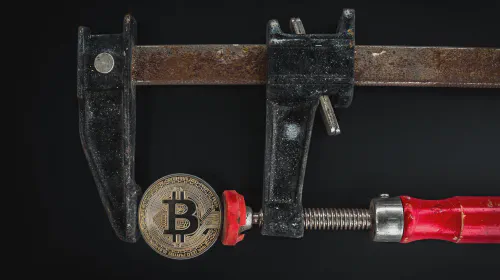Ethereum vs. Ethereum 2.0: Key Differences Explained
Salomon Kisters
May 12, 2022This post may contain affiliate links. If you use these links to buy something we may earn a commission. Thanks!
If you have been following Ethereum, you must have heard about Ethereum 2.0. What is it, and how is it different from the old Ethereum?
Ethereum is a blockchain that uses PoW (Proof of Work) to confirm transactions, but it will be transitioning into an updated version called Ethereum 2.0, which utilizes PoS (Proof of Stake) for this function instead.
Anyone who has been in the crypto space even for a short while is familiar with the name Ethereum. The second-largest cryptocurrency after Bitcoin and a blockchain home to numerous NFTs and DeFi projects, Ethereum has branched into digital money, global payments, as well as applications.
However, if you have been following the project for the past few months, you must have heard about Ethereum 2.0 – also known as the new Ethereum.
Yet, unless you are blockchain-savvy, the expression is really confusing and raises several questions. Have they released a new ETH coin? Are there two different Ethereum blockchains now? Is Ethereum 2.0 better than Ethereum?
This article will help you understand what you need to know about Ethereum 2.0 and the difference between Ethereum and Ethereum 2.0.
What is Ethereum?
Before tackling the complexities around this new upgrade, let’s first refresh our knowledge about Ethereum.
Ethereum is an open-source, decentralized blockchain-based platform launched on July 30, 2015, by a Canadian-Russian programmer, Vitalik Buterin. It was one of the first cryptocurrencies to have smart contract technology embedded into its blockchain. Hence, its launch marked the birth of second-generation blockchain technology.
Thanks to smart contracts, programmers worldwide can use the blockchain to develop a wide variety of decentralized applications (DApps). As a result, Ethereum gave way to some of the biggest crypto innovations today, such as NFTs and blockchain-based games.
What is Ethereum 2.0?
Have you ever experienced that when you opened an application, it notified you to update it before using it? So you confirm and wait for it to complete. After it’s done, you find the new version to have an entirely different interface with better functionality and more productivity.
Think of Ethereum 2.0 (aka ETH 2 and Serenity) in the same way. Contrary to most people’s first impression after hearing the news, Ethereum 2.0 is NOT a new blockchain. In fact, it is a set of interconnected updates to the existing mechanism.
So as an investor, you don’t need to worry about the ETH tokens stored in your wallet.
These updates aim to culminate the shift from the Proof of Work (PoW) consensus model to the newer Proof of Stake (PoS) consensus model. It will help Ethereum catch up with some of the newer blockchains, such as Cardano, Polkadot, Solana, etc., that are already using the PoS model.
It is also worth mentioning that this shift to the PoS model is not at all sudden or unexpected. These updates have been a part of Ethereum’s roadmap for a long time in order to achieve the following objects:
1. Security
One of the primary goals of the Ethereum community is to make the platform more secure for investors and developers. In the past, we have seen several hacking incidents on different blockchains that resulted in people losing their money. Moving towards a PoS system, at least in theory, will minimize the risk of cyberattacks.
Moreover, it can also deal with a risk that comes with a 51% attack threat. Being a decentralized platform, Ethereum’s developers have to make sure that no single party manages to take over the majority of the network.
2. Scalability
As mentioned earlier, Ethereum hosts a massive number of DApps and DeFi services. According to the data collected from different sources, Ethereum is home to almost 80% of the total DeFi apps, and about 90% of all the NFTs are part of its ecosystem. Such activity leads to huge traffic and thousands of transactions happening all the time.
However, the older Ethereum blockchain could handle only 15 transactions per second. It caused the users to pay high transaction fees and deal with delayed transfers.
3. Sustainability
If a new project needs to make its presence felt in the world of blockchain, becoming eco-friendly is the most important thing it has to do. The older PoW consensus model required Ethereum’s blockchain to depend on mining.
Miners had to use highly-complicated computing devices, which consumed massive amounts of electricity. The newer PoS model, in sharp contrast, puts an end to the entire mining network, making Ethereum more sustainable and eco-friendly.
Proof of Work vs. Proof of Stake
To fully grasp the next section, which will go a bit more technical from now on, it’s important to be clear about the main consensus models.
Unlike the traditional financial system, where the banks confirm every payment and credit transfer, cryptocurrencies are decentralized. This means that every blockchain needs a mechanism to check the legitimacy of the transactions before validating them. This is where cryptographic mining comes into the picture.
Both PoW and PoS are crypto mining mechanisms that provide a consensus model to authenticate transactions.
In the PoW model, a network of users (miners) around the world race against each other to solve a highly complex algorithm. Each time this algorithm is solved, a new data block is added to the blockchain.
These blocks are full of transaction records and, once completed, are locked for eternity. The miner who wins the race is rewarded with some tokens. The problem with this method is that miners have to use heavy computing devices, which consume a lot of electricity.
On the other hand, the PoS model does not require miners to decode the 64-digit hexadecimal key to add a new block to the chain. Instead, the procedure involves users (stakers) locking their funds on the blockchain to participate in mining. Then the blockchain itself checks and approves all transactions without relying on computing power. When a new block is added successfully, users who staked their funds are rewarded with more tokens.
The Most Prominent Differences between Ethereum & Ethereum 2.0
1. Change in Consensus Mechanism
Since the shift to the PoS mechanism in the latter half of the last year, the Ethereum blockchain randomly selects an ETH holder. The selected holder (validator) is then trusted with the responsibility to hash the new block.
To become a validator, you have to stake at least 32 ETH. Holders with fewer funds who still want to participate can join staking pools.
To protect the blockchain from scams and frauds, any validator who is caught authenticating illegitimate transactions faces a reduction in his staked funds. This process is called slashing.
Apart from being sustainable, the PoS mechanism also helps Ethereum 2.0 become more decentralized than the older Ethereum. Since users don’t have to buy expensive rigs anymore, anyone with a certain amount of ETH can participate in mining new tokens. As a result, more user participation leads to more decentralization.
2. Sharding
Another important update that makes Ethereum 2.0 different from the classic Ethereum is sharding.
Sharding is a common phenomenon in the general programming world, in which the data is distributed in several machines to improve the processing speed. Similarly, in the case of Ethereum, it has been done by introducing 64 shards.
Each shard is basically a new chain connected to the older Ethereum chain to link with the previously recorded data. Moreover, all of them will work the same way as the old one did, except for the difference that now workload has been distributed onto multiple databases.
Sharding directly addresses Ethereum’s scalability concerns. Unlike the classic Ethereum, which could handle only 15 transactions per second, Ethereum 2.0 is much more efficient, completing up to 100,000 transactions each second.
To give you a better idea, think of the older Ethereum blockchain as a very busy highway with just one lane. But after the recent upgrade, 63 new lanes have been added to this highway. This has not only made the traffic flow smoother but has also increased the speed with which it can move.
3. Beacon Chain
We just discussed how Ethereum 2.0 is divided into 64 different chains and how validators are selected to add a new data block to them. But there has to be something that connects each of these chains and decides who will be selected as a validator, right? This question brings us to the last major difference between ETH and ETH 2.
All 64 sharded chains are connected to one blockchain, which controls all of them and enables transactions throughout the network. This central component is the brain of the entire ecosystem and is named Beacon Chain.
One more essential function of the Beacon Chain is to randomly nominate the next validator and monitor its activity. It is also responsible for slashing the staked amount if an exploitative attempt is detected. The randomness in validator selection is important to ensure that the system is not biased toward one specific participant.
Wrapping Up
Ethereum 2.0 is a step in the right direction. All the updates it brought after years of continuous hard work are a testament to the dedication of the Ethereum team.
As far as the value goes, the upgrade has made Ethereum’s foundations in the crypto market even stronger. It should give the ETH token a positive boost over the long run. Stay tuned for more changes to come, and watch how Ethereum tackles future challenges.
Stay informed with the latest insights in Crypto, Blockchain, and Cyber-Security! Subscribe to our newsletter now to receive exclusive updates, expert analyses, and current developments directly to your inbox. Don't miss the opportunity to expand your knowledge and stay up-to-date.
Love what you're reading? Subscribe for top stories in Crypto, Blockchain, and Cyber-Security. Stay informed with exclusive updates.
Please note that the Content may have been generated with the Help of AI. The editorial content of OriginStamp AG does not constitute a recommendation for investment or purchase advice. In principle, an investment can also lead to a total loss. Therefore, please seek advice before making an investment decision.

The Mystery of the Message in the Bitcoin Genesis Block
When Satoshi Nakamoto created Bitcoin, he left a secret message. What is it, and what does it mean?

Can The Blockchain Be Hacked Or Attacked?
Blockchain technology and cryptocurrencies have seen a massive surge in popularity. Can they be hacked?

Why Can There Only Be 21 Million Bitcoins? Impact of Bitcoin's Fixed Supply
Discover why there can only be 21 million Bitcoins and the impact of Bitcoin's fixed supply on inflation control and scarcity.
Protect your documents
Your gateway to unforgeable data. Imprint the authenticity of your information with our blockchain timestamp